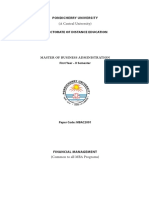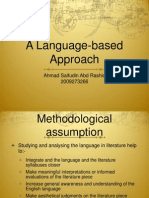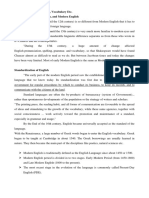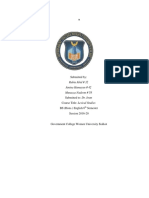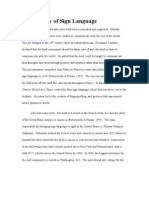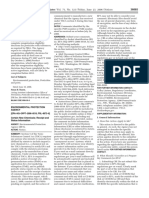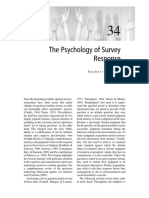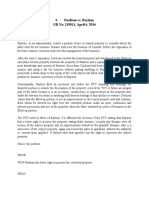0 ratings0% found this document useful (0 votes)
216 viewsDaniel Jones: A Famous British Phonetician
Daniel Jones: A Famous British Phonetician
Uploaded by
Оксана КачуловаDaniel Jones was a famous British phonetician born in 1881. He studied phonetics in Germany and Paris, and had a long career at University College London where he became the head of the Department of Phonetics in 1912. Jones made many important contributions to phonetics, including developing the cardinal vowel diagram and publishing the influential English Pronouncing Dictionary. He was also known for his work analyzing the sound systems of many other languages like Cantonese, Tswana, Sinhalese, and Russian.
Copyright:
© All Rights Reserved
Available Formats
Download as PPTX, PDF, TXT or read online from Scribd
Daniel Jones: A Famous British Phonetician
Daniel Jones: A Famous British Phonetician
Uploaded by
Оксана Качулова0 ratings0% found this document useful (0 votes)
216 views10 pagesDaniel Jones was a famous British phonetician born in 1881. He studied phonetics in Germany and Paris, and had a long career at University College London where he became the head of the Department of Phonetics in 1912. Jones made many important contributions to phonetics, including developing the cardinal vowel diagram and publishing the influential English Pronouncing Dictionary. He was also known for his work analyzing the sound systems of many other languages like Cantonese, Tswana, Sinhalese, and Russian.
Original Title
Phonetics_Daniel Jones
Copyright
© © All Rights Reserved
Available Formats
PPTX, PDF, TXT or read online from Scribd
Share this document
Did you find this document useful?
Is this content inappropriate?
Daniel Jones was a famous British phonetician born in 1881. He studied phonetics in Germany and Paris, and had a long career at University College London where he became the head of the Department of Phonetics in 1912. Jones made many important contributions to phonetics, including developing the cardinal vowel diagram and publishing the influential English Pronouncing Dictionary. He was also known for his work analyzing the sound systems of many other languages like Cantonese, Tswana, Sinhalese, and Russian.
Copyright:
© All Rights Reserved
Available Formats
Download as PPTX, PDF, TXT or read online from Scribd
Download as pptx, pdf, or txt
0 ratings0% found this document useful (0 votes)
216 views10 pagesDaniel Jones: A Famous British Phonetician
Daniel Jones: A Famous British Phonetician
Uploaded by
Оксана КачуловаDaniel Jones was a famous British phonetician born in 1881. He studied phonetics in Germany and Paris, and had a long career at University College London where he became the head of the Department of Phonetics in 1912. Jones made many important contributions to phonetics, including developing the cardinal vowel diagram and publishing the influential English Pronouncing Dictionary. He was also known for his work analyzing the sound systems of many other languages like Cantonese, Tswana, Sinhalese, and Russian.
Copyright:
© All Rights Reserved
Available Formats
Download as PPTX, PDF, TXT or read online from Scribd
Download as pptx, pdf, or txt
You are on page 1of 10
DANIEL JONES
A FAMOUS BRITISH
PHONETICIAN
Presentation is made by Oksana Kachulova
Bitrh
Daniel Jones was born in
London, United Kingdom,
on September 12, 1881.
Education
In 1900, Jones studied
briefly at William Tilly's
Marburg Language Institute
in Germany, where he was
first introduced to
phonetics.
In 1903, he received his BA
degree in mathematics at
Cambridge, converted by
payment to MA in 1907.
Education
From 1905 to 1906, he
studied in Paris under
Paul Passy, who was one
of the founders of the
International Phonetic
Association.
He briefly took private
lessons from the British
phonetician Henry
Sweet.
Carrier
In 1907, he became a part-time lecturer at
University College London and was
afterwards appointed to a full-time
position.
In 1912, he became the head of the
Department of Phonetics and was
appointed to a chair in 1921, a post he held
until his retirement in 1949.
From 1906 onwards, Jones was an active
member of the International Phonetic
Association, and was Assistant Secretary
from 1907 to 1927, Secretary from 1927 to
1949, and President from 1950 to 1967.
After retirement, Jones worked assiduously
at his publications almost up to the end of
his long life.
Works
In 1909, Jones wrote the short
Pronunciation of English, a book he
later radically revised. The resulting
work, An Outline of English
Phonetics, followed in 1918 and is
the first truly comprehensive
description of British Received
Pronunciation, and the first such
description of the standard
pronunciation of any language.
Works
The year 1917 was a landmark for Jones
in many ways. He became the first linguist
in the western world to use the term
phoneme in its current sense, employing
the word in his article "The phonetic
structure of the Sechuana Language".
Jones had made an earlier notable attempt
at a pronunciation dictionary but it was
now that he produced the first edition of
his famous English Pronouncing
Dictionary, a work which in revised form
is still in print. It was here that the
cardinal vowel diagram made a first
appearance.
Achievements
The problem of the phonetic description of vowels is of long standing, going back
to the era of the ancient Indian linguists. Three nineteenth-century British
phoneticians worked on this topic. Jones however was the one who is generally
credited with having gone much of the way towards a practical solution through his
scheme of 'Cardinal Vowels', a relatively simple system of reference vowels which
for many years has been taught systematically to students within the British
tradition.
Achievements
Although Jones is especially remembered for his
work on the phonetics and phonology of English,
he ranged far more widely. He produced
phonetic/phonolological treatments which were
masterly for their time on the sound systems of
Cantonese, Tswana (Sechuana as it was then
known), Sinhalese, and Russian. He was the first
phonetician to produce, in his "Sechuana Reader",
a competent description of an African tone
language, including the concept of downstep.
Jones helped develop new alphabets for African
languages, and suggested systems of romanisation
for Indian languages and Japanese. He also busied
himself with support for revised spelling for
English through the Simplified Spelling Society.
Marriage
He studied phonetics
under Paul Passy,
whose niece Cyrille
Motte he married in
1911.
You might also like
- 2023-08-28 (Public) Verified Shareholder Derivative ComplaintDocument77 pages2023-08-28 (Public) Verified Shareholder Derivative ComplaintJeff Foust100% (1)
- 5 4 Kirkpatrick 2014Document6 pages5 4 Kirkpatrick 2014chodzszogunieNo ratings yet
- Discipline:Theory Ofenglishlanguage Siw:Prepare A Report of Outstanding PhoneticianDocument7 pagesDiscipline:Theory Ofenglishlanguage Siw:Prepare A Report of Outstanding Phoneticianinsi 7No ratings yet
- Written Language (Unit 16)Document1 pageWritten Language (Unit 16)Maryam RazaNo ratings yet
- Financial Management-230113 PDFDocument283 pagesFinancial Management-230113 PDFmaheswaran100% (2)
- Power Commercial Industrial V CaDocument2 pagesPower Commercial Industrial V CaAnnHopeLove100% (3)
- Teaching Cultural Concepts Through LanguageDocument6 pagesTeaching Cultural Concepts Through LanguageResearch ParkNo ratings yet
- Verner'S LAW: Made By: Selina Daria UT-20-1Document8 pagesVerner'S LAW: Made By: Selina Daria UT-20-1Дарья СелинаNo ratings yet
- Impact of Globalization On English LanguageDocument3 pagesImpact of Globalization On English LanguageKenny AnayNo ratings yet
- Language Based ApproachDocument12 pagesLanguage Based ApproachDydy Midnite100% (1)
- Functions of Intonation by David Crystal Emotional: ProsodyDocument6 pagesFunctions of Intonation by David Crystal Emotional: ProsodyLera BaliukNo ratings yet
- The Role of Semi-VowelsDocument12 pagesThe Role of Semi-VowelsPaolita SuarezNo ratings yet
- Q. Varieties of English in South AsiaDocument18 pagesQ. Varieties of English in South AsiaIelts John AcademyNo ratings yet
- Definition of GrammarDocument3 pagesDefinition of GrammarBishnu Pada Roy0% (1)
- A Lexico-Syntactic AnalysisDocument17 pagesA Lexico-Syntactic Analysissenior_2011No ratings yet
- History of LinguisticsDocument12 pagesHistory of LinguisticsSa MiraNo ratings yet
- A Brief History of Early Linguistics of The 18th and 19th CenturyDocument4 pagesA Brief History of Early Linguistics of The 18th and 19th CenturyKevin Stein100% (3)
- The Process of Standardization in EnglishDocument6 pagesThe Process of Standardization in Englishkamie1550% (1)
- Presentation 08 - Ethnicity and Social NetworksDocument56 pagesPresentation 08 - Ethnicity and Social NetworksIntan Fadila HusnaNo ratings yet
- College EnglishDocument7 pagesCollege EnglishYanyan OrozcoNo ratings yet
- How Modern English Is Different From Old EnglishDocument3 pagesHow Modern English Is Different From Old EnglishSuryajeeva Sures100% (1)
- Assignment 1 Speech and Language (1,2,3,5)Document11 pagesAssignment 1 Speech and Language (1,2,3,5)Kyleruwlz FizrdNo ratings yet
- Modern English: Grammar, Vocabulary Etc. Old English, Middle English, and Modern EnglishDocument3 pagesModern English: Grammar, Vocabulary Etc. Old English, Middle English, and Modern EnglishSr Chandrodaya J100% (1)
- Survey of Afro Asian LiteratureDocument264 pagesSurvey of Afro Asian LiteratureMitchelle OndanganNo ratings yet
- Subtractive and Aditive BilingualismDocument9 pagesSubtractive and Aditive BilingualismAida Araceli Lizárraga ÁvilaNo ratings yet
- The Direct Method of Teaching EnglishDocument7 pagesThe Direct Method of Teaching EnglishVisitacion Sunshine BaradiNo ratings yet
- Theories of Creole GenesisDocument26 pagesTheories of Creole GenesisAbel Djassi100% (2)
- Ethnicity and Social Networks 11Document18 pagesEthnicity and Social Networks 11radinsa yolacd100% (1)
- PINGLISH (Pakistani English)Document6 pagesPINGLISH (Pakistani English)rabiaNo ratings yet
- Properties of Human LanguageDocument17 pagesProperties of Human LanguageVenera Moldakulova100% (1)
- Dominance TheoryDocument3 pagesDominance TheoryAngel Gutiérrez Tiempo0% (1)
- Jessner 2008 Teaching Third LanguagesDocument42 pagesJessner 2008 Teaching Third LanguagesmasohaNo ratings yet
- CA - English Izon Isoko Languages MorphologyDocument6 pagesCA - English Izon Isoko Languages MorphologyELDA P. SAYA-ANGNo ratings yet
- 11 - Chapter 5-Phonological AnalysisDocument50 pages11 - Chapter 5-Phonological AnalysisArzu KhanNo ratings yet
- A Contrastive Analysis of English and Hausa Proverbs in Selected TextsDocument144 pagesA Contrastive Analysis of English and Hausa Proverbs in Selected Textsobimo100% (2)
- Lecture Note # 5 The Old English and The Middle English PeriodDocument3 pagesLecture Note # 5 The Old English and The Middle English PeriodVenus BravoNo ratings yet
- The Nature of Applied Linguistics (AILA)Document6 pagesThe Nature of Applied Linguistics (AILA)api-19787247No ratings yet
- Key Events in Old, Middle & Modern EnglishDocument5 pagesKey Events in Old, Middle & Modern EnglishDark N ShineNo ratings yet
- Course Notes On Language and National DevelopmentDocument42 pagesCourse Notes On Language and National Developmentdammydave4No ratings yet
- Psycholinguistics Language and ThoughtDocument7 pagesPsycholinguistics Language and ThoughtNesrine AtiNo ratings yet
- The Major Dialects in The PhilippinesDocument3 pagesThe Major Dialects in The PhilippinesAce ZenNo ratings yet
- Hebrew LiteratureDocument5 pagesHebrew LiteratureJessica Corona - Mariano100% (1)
- Presentation - 1st Week - Spread of World EnglishDocument11 pagesPresentation - 1st Week - Spread of World EnglishCandan ülküNo ratings yet
- The Oral Approach and SituatioanalDocument5 pagesThe Oral Approach and SituatioanalKaka NurNo ratings yet
- Categories of AffixesDocument4 pagesCategories of AffixesTrisha May Ara AnaretaNo ratings yet
- ياسمين حكمت.بدون اخطاءDocument130 pagesياسمين حكمت.بدون اخطاءMiss MemNo ratings yet
- Structural Approach in Teaching LanguageDocument24 pagesStructural Approach in Teaching LanguageJuan Miguel TangkekoNo ratings yet
- Hisotry of English LanguageDocument3 pagesHisotry of English Languagejackie alvarezNo ratings yet
- 09 Chapter 2Document33 pages09 Chapter 2Lhichie-u PuroNo ratings yet
- Chapter 7 GrammarDocument29 pagesChapter 7 Grammarواثق جليل عودة حماديNo ratings yet
- Understanding Poetry - PowerPointDocument33 pagesUnderstanding Poetry - PowerPointVivian Ana Aguilar GorospeNo ratings yet
- Arabian LiteratureDocument3 pagesArabian LiteratureMishie BercillaNo ratings yet
- Syllabus DesignDocument18 pagesSyllabus DesignAnonymous Wj6Bhcbw100% (1)
- Pidgins and CreoleDocument15 pagesPidgins and CreoleRizky Eka PrasetyaNo ratings yet
- The History of Sign LanguageDocument5 pagesThe History of Sign LanguageJong Yii PhinNo ratings yet
- Morph Processes in English & IgalaDocument30 pagesMorph Processes in English & IgalaUnubi Sunday AbrahamNo ratings yet
- Regional and Social Dialectology PresentationDocument22 pagesRegional and Social Dialectology PresentationMa. Elarnie L. Modesto100% (1)
- A Brief History of LinguisticsDocument3 pagesA Brief History of LinguisticsDaniel Duma100% (3)
- Lecture Slide 2 Origin of Bangalees - Bangladesh - Bangla LanguageDocument16 pagesLecture Slide 2 Origin of Bangalees - Bangladesh - Bangla LanguageManjare Hassin RaadNo ratings yet
- The Language System of EnglishDocument25 pagesThe Language System of EnglishTee FleNo ratings yet
- Advanced PhonologyDocument35 pagesAdvanced PhonologySania AshirNo ratings yet
- London School of LinguisticsDocument2 pagesLondon School of LinguisticsbunymarcoNo ratings yet
- Compare Contrast Among Merger Acquisition Joint Venture Strategic AlliancesDocument5 pagesCompare Contrast Among Merger Acquisition Joint Venture Strategic AlliancesKhairun AmalaNo ratings yet
- Carrie MoldremDocument3 pagesCarrie Moldremchandu rajuNo ratings yet
- CHN1 Course Outline 20 - 21Document14 pagesCHN1 Course Outline 20 - 21Edna Uneta RoblesNo ratings yet
- Chapter 14 NotesDocument2 pagesChapter 14 NotesmylittlespammyNo ratings yet
- 3 Cuckoo Clock Part 1Document16 pages3 Cuckoo Clock Part 1hcy002No ratings yet
- Notice: Environmental Statements Availability, Etc.: New Chemicals, Receipt and Status InformationDocument4 pagesNotice: Environmental Statements Availability, Etc.: New Chemicals, Receipt and Status InformationJustia.comNo ratings yet
- AEE 1350-1353 Transcripts EpisodesDocument53 pagesAEE 1350-1353 Transcripts EpisodesAnonymous mZ54AbOuNo ratings yet
- Hse Gaurav Sharda CVDocument4 pagesHse Gaurav Sharda CVSalva KhanNo ratings yet
- Spy Training 101: Wisdom From Michael Westen in Burn Notice Seasons 1-3Document17 pagesSpy Training 101: Wisdom From Michael Westen in Burn Notice Seasons 1-3nunukantaNo ratings yet
- Explanation by SlideDocument8 pagesExplanation by SlideMaeven TubayanNo ratings yet
- Skills Test 1&2: 1 Listen and Circle The Correct AnswerDocument6 pagesSkills Test 1&2: 1 Listen and Circle The Correct AnswerMaxi ComasNo ratings yet
- Nursing Manangment of Older PersonDocument5 pagesNursing Manangment of Older PersonRaiden VizcondeNo ratings yet
- Pre Board Social ScienceDocument13 pagesPre Board Social ScienceHanz Luis AnzanoNo ratings yet
- Genesis of A Vertical City in HongkongDocument9 pagesGenesis of A Vertical City in HongkongVinay GoyalNo ratings yet
- Uttarabhadrapada Nakshatra - Vishnu SahasranamaDocument4 pagesUttarabhadrapada Nakshatra - Vishnu SahasranamaDeepak PoojariNo ratings yet
- Schwartz, Norbert. 2008. The Psychology of Survey ResponseDocument14 pagesSchwartz, Norbert. 2008. The Psychology of Survey ResponseKaryta NuñezNo ratings yet
- Daclison vs. Baytion GR No. 219811, April 6, 2016: FactsDocument2 pagesDaclison vs. Baytion GR No. 219811, April 6, 2016: FactsChris Ronnel Cabrito CatubaoNo ratings yet
- 105 Spelling For Bank PDFDocument24 pages105 Spelling For Bank PDFKawsher Raquib100% (3)
- Air Cadet Drill ManualDocument90 pagesAir Cadet Drill ManualnoahboccongelleNo ratings yet
- The Generic Structure of Narrative TextDocument3 pagesThe Generic Structure of Narrative TextdhifanfanNo ratings yet
- Boarder TcsreportDocument101 pagesBoarder TcsreportFatima ShahidNo ratings yet
- Corporate Compliance Management KR ChandratreDocument35 pagesCorporate Compliance Management KR ChandratrewritheNo ratings yet
- SSTORY Hemingway, Ernest The Killers (1927) Analysis PDFDocument2 pagesSSTORY Hemingway, Ernest The Killers (1927) Analysis PDFGermán Ramírez HuertaNo ratings yet
- Republic vs. CA (G.R. No. 163604)Document5 pagesRepublic vs. CA (G.R. No. 163604)info.ronspmNo ratings yet
- Install Kali Linux On Virtualbox in 3 Easy Steps - LinuxForDevicesDocument11 pagesInstall Kali Linux On Virtualbox in 3 Easy Steps - LinuxForDevicesjpaul42391No ratings yet
- 9780203552162_previewpdfDocument38 pages9780203552162_previewpdfPriya KashyapNo ratings yet
- Distribution Center: Navigation SearchDocument6 pagesDistribution Center: Navigation SearchsaipuppalaNo ratings yet




